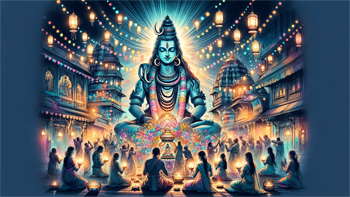Maha Shivaratri, a festival celebrated with immense fervor and devotion, holds a special place in the hearts of millions of Hindus worldwide. This sacred day, dedicated to Lord Shiva, one of the principal deities in Hinduism, embodies the spirit of devotion, penance, and enlightenment. Maha Shivaratri is not just a religious event; it's a cultural phenomenon that brings together people from diverse backgrounds to celebrate the cosmic dance of Lord Shiva, also known as 'Nataraja', the lord of dancers.
The Significance of Maha Shivaratri
The significance of Maha Shivaratri lies in its representation of the victory of light over darkness and ignorance. It is believed that on this auspicious night, Lord Shiva performed the 'Tandava', the dance of creation, preservation, and destruction. The festival also marks the day when Lord Shiva married Goddess Parvati, symbolizing the union of divine energy. Devotees observe fasts, sing hymns, and offer prayers to Lord Shiva, seeking his blessings for wellbeing and spiritual growth. The belief that observing Maha Shivaratri can lead one to the path of righteousness and liberation from the cycle of birth and rebirth is a strong motivator for the devotees.
Traditions and Rituals
Maha Shivaratri is celebrated with a series of rituals that are rich in symbolism and tradition. Devotees visit temples or set up altars at home to perform the 'Shiva Pooja' at midnight, the time believed to be the most auspicious. Offerings of milk, honey, water, and bael leaves are made to the Shiva Lingam, the iconic representation of Lord Shiva. This ritual, known as 'Abhishekam', symbolizes purification of the soul. The chanting of mantras, such as the sacred 'Om Namah Shivaya', resonates in the air, creating a spiritually charged environment. Temples are adorned with lights and flowers, and the air is filled with devotional songs and dances, adding to the ethereal atmosphere of the night.
Cultural Impact and Celebrations Across India
Maha Shivaratri is celebrated across India, but the manner of celebration varies from region to region, showcasing the country's rich cultural diversity. In Varanasi, one of the holiest cities in India, Maha Shivaratri is celebrated with great pomp and show. Devotees take holy dips in the Ganges and participate in the grand procession carrying the idols of Lord Shiva. In the southern state of Tamil Nadu, devotees perform classical dances like Bharatanatyam in temples, paying homage to Lord Shiva, the lord of dance. Meanwhile, in the northern regions, particularly in the state of Himachal Pradesh, fairs and cultural programs mark the occasion, bringing communities together in a spirit of joy and brotherhood.
Global Influence and Participation
With the Indian diaspora spread across the globe, Maha Shivaratri has become a global festival. Temples in countries like the United States, United Kingdom, Australia, and Canada organize special events and rituals, allowing the Indian community and others interested in Indian culture to participate in the festivities. This global participation not only preserves the cultural identity but also promotes cross-cultural understanding and harmony. In many international cities, Maha Shivaratri provides a glimpse into the rich tapestry of Indian tradition and spirituality.
Health and Spiritual Benefits
Observing fasts during Maha Shivaratri has its roots in ancient practices that are believed to have health and spiritual benefits. Fasting helps detoxify the body and aids in mental discipline. It is also a time for self-reflection and meditation, allowing devotees to introspect and realign with their spiritual goals. The practice of staying awake through the night and chanting prayers is seen as a means to overcome ignorance and realize one's inner self. This spiritual awakening is central to the essence of Maha Shivaratri, guiding individuals towards enlightenment and inner peace.
Environmental and Social Consciousness
In recent years, Maha Shivaratri has also become a platform for promoting environmental and social consciousness. Many organizations use this occasion to spread awareness about conserving nature, as Lord Shiva is also regarded as the protector of the environment. Initiatives for tree planting, clean-up drives in and around temple areas, and awareness campaigns about sustainable practices are common. Additionally, the festival fosters a sense of community service, with many volunteers engaging in feeding the poor and offering help to the needy, embodying the principles of compassion and service inherent in the festival's ethos.
Maha Shivaratri is not just a religious observance; it is a vibrant testament to India's spiritual and cultural heritage. It encapsulates the ethos of devotion, the joy of celebration, and the pursuit of spiritual enlightenment. Whether one participates in the rituals, observes the fasts, or simply takes part in the communal joy, Maha Shivaratri offers a unique experience that leaves an indelible mark on the heart and soul. This festival, transcending geographical and cultural boundaries, continues to inspire and unite people in a timeless celebration of life, devotion, and cosmic harmony.
